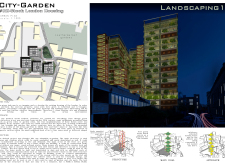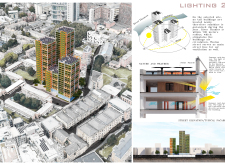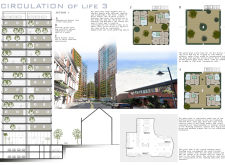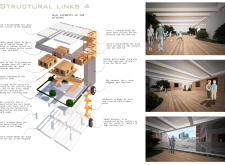5 key facts about this project
At its core, the project stands as a multipurpose facility, cleverly integrating various programmatic elements to cater to the diverse needs of its users. The design incorporates communal spaces that encourage social interaction, workspaces that foster productivity, and areas dedicated to leisure and creativity. This multifunctionality is not merely an afterthought but is intricately woven into the architecture, evident through the thoughtful arrangement of spaces and the integration of natural light, which plays a pivotal role in enhancing the overall ambiance.
In terms of materiality, the project utilizes a combination of sustainable and locally sourced materials. These include reclaimed wood, which adds warmth and texture, as well as steel and glass, which contribute to a modern aesthetic while ensuring structural integrity. The choice of materials is tied to the project's commitment to sustainability—each element is chosen not only for its visual impact but also for its minimal environmental footprint. The extensive use of large windows and skylights further promotes daylight penetration while fostering a connection between the interior spaces and the natural surroundings.
One of the unique design approaches of this project lies in its response to the local climate. The building's orientation and fenestration strategy are meticulously planned to optimize energy efficiency. The overhanging roofs and strategically placed shading devices mitigate heat gain, while the incorporation of green roofs and vertical gardens enhances thermal performance and promotes biodiversity. Such design decisions reflect a deep understanding of the local environment and the architectural responsibility towards reducing energy consumption.
The exterior façade is a harmonious blend of solid and void, with structural elements that create an engaging interplay of light and shadow throughout the day. The patterning on the facade, derived from local cultural motifs, adds a layer of identity to the building, allowing it to resonate with the community it serves. This thoughtful integration of cultural references not only enriches the architectural narrative but also promotes a sense of belonging among the users.
Inside, the project is characterized by an open-plan layout that encourages collaboration and interaction. The interior spaces are adaptable, allowing for various configurations according to the user’s needs, which is essential in a multifunctional design. High ceilings and open corridors create a sense of spaciousness, while the careful placement of furniture and partitions maintains an intimate and inviting atmosphere.
Furthermore, the project incorporates advanced technologies to facilitate a smart building environment. Energy-efficient systems, smart lighting, and innovative building management solutions are integrated to enhance user experience while minimizing environmental impact. This not only streamlines operations but also elevates the overall functionality of the building.
Engagement with the community is at the heart of this architectural endeavor. The design incorporates public areas that encourage local gatherings, events, and activities, fostering a vibrant community spirit. The landscape design complements the architectural elements, with pathways and green spaces that invite people to explore and connect. This design ethos underscores the importance of architecture as a medium for social interaction and community development.
In summary, this architectural project is a clear reflection of contemporary design principles, addressing both aesthetic and functional requirements through sustainable practices and innovative thinking. The careful selection of materials, harmonious blending with the environment, and commitment to community engagement highlight the project's significance in the realm of modern architecture. For those interested in delving deeper into this project, exploring the architectural plans, sections, designs, and ideas will provide valuable insights into the thoughtful design and execution behind this remarkable structure.


























